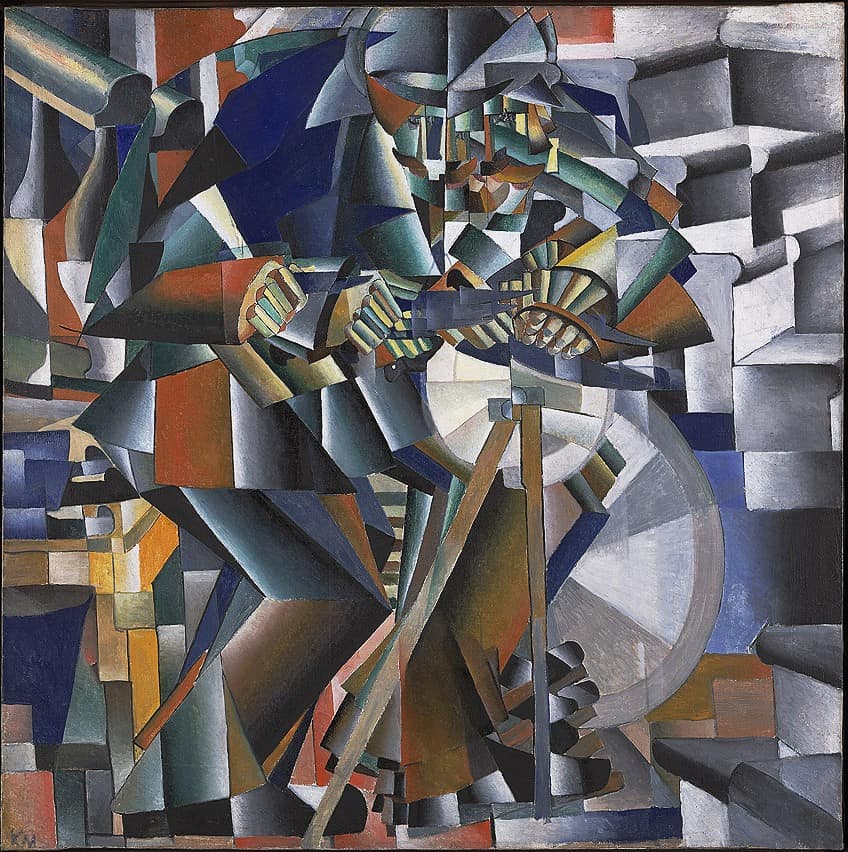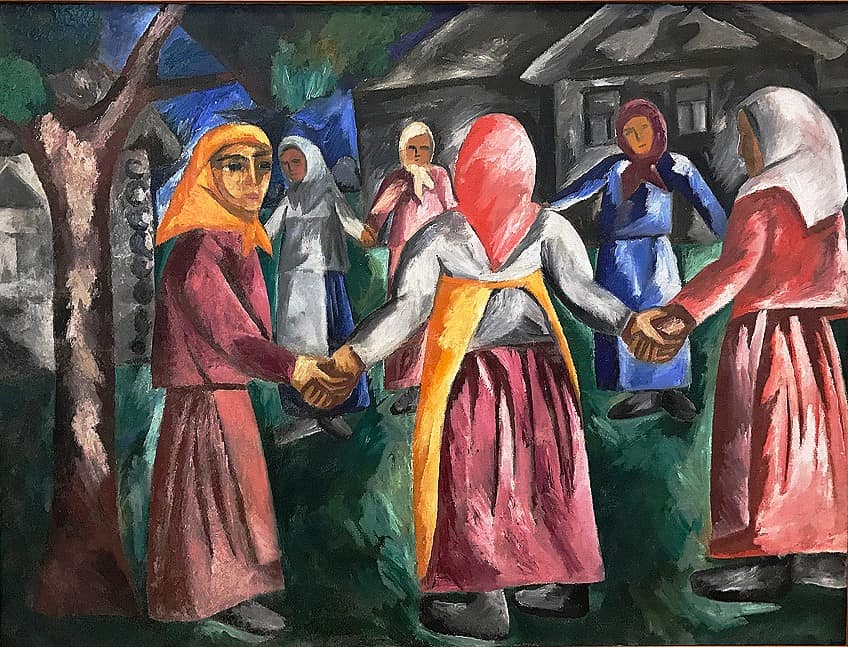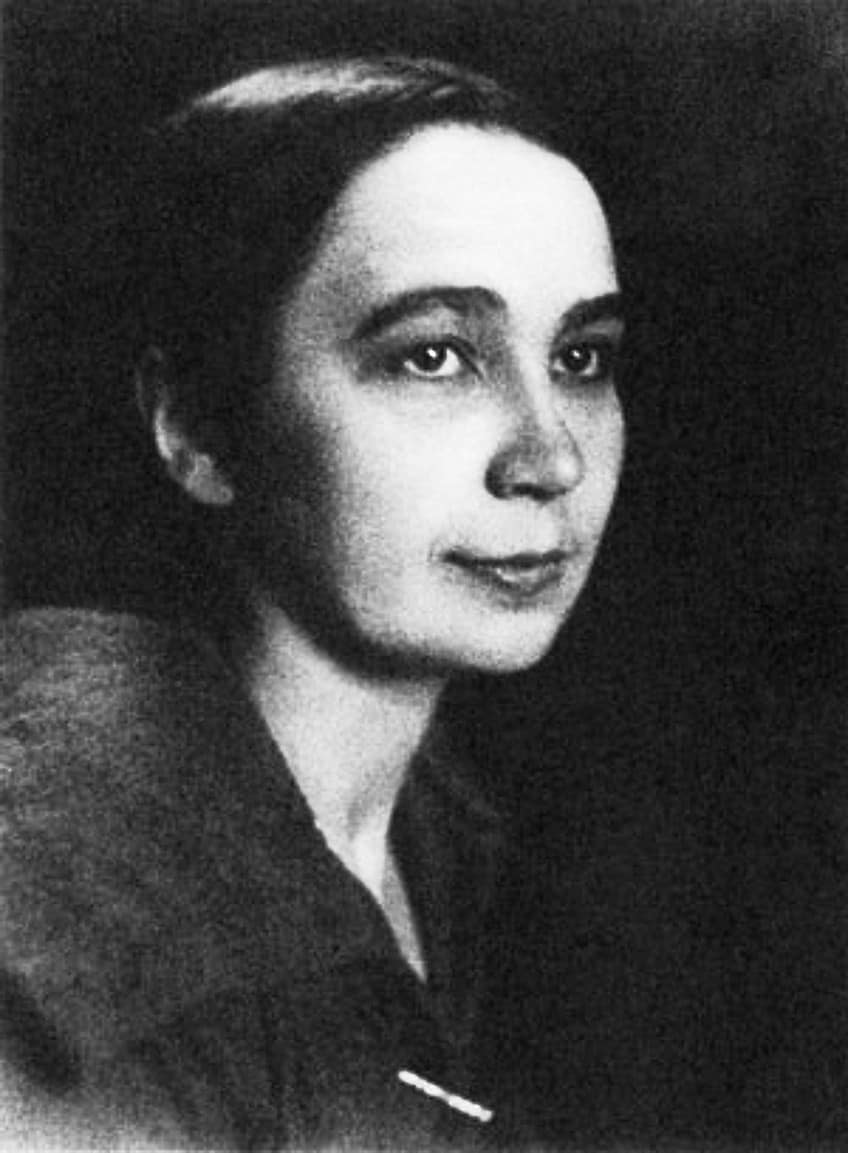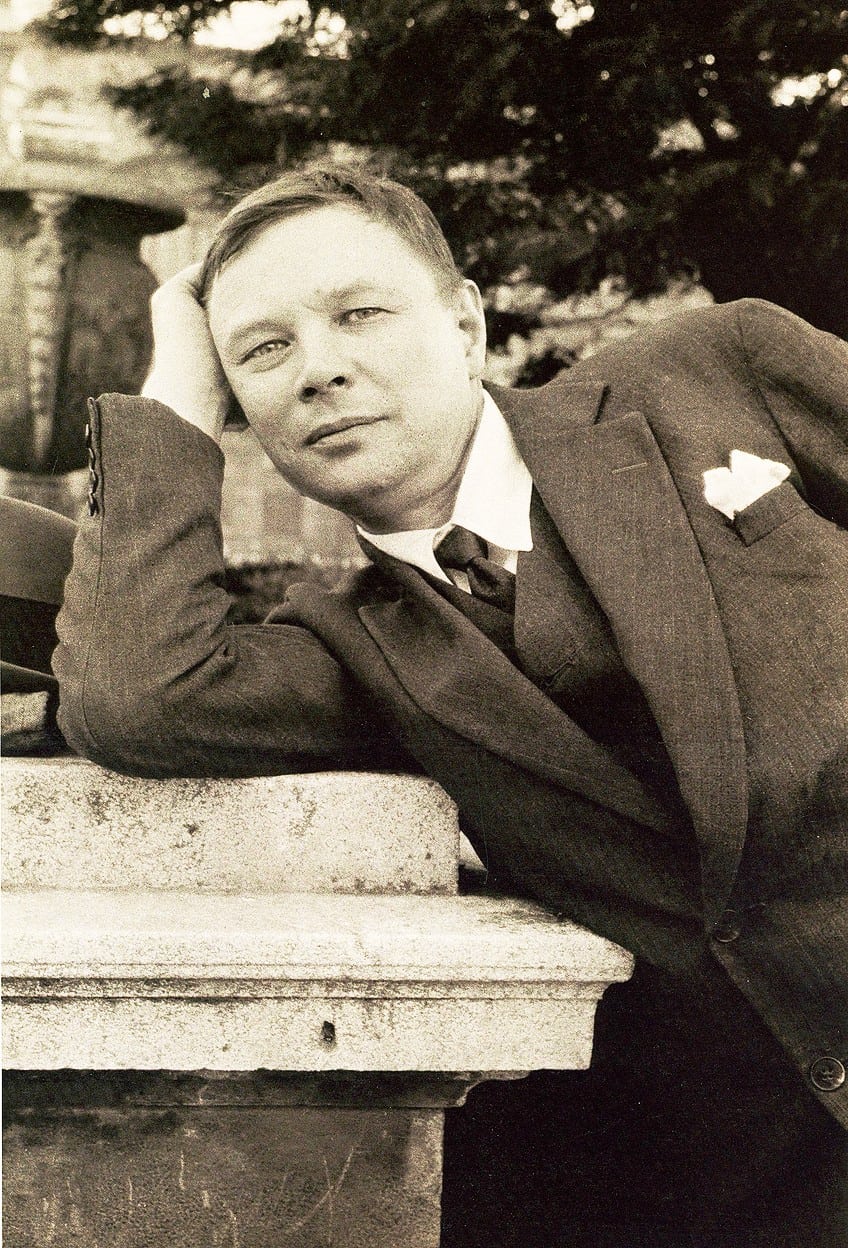Neo-Primitivism – Discover the Style of Neo-Primitivism Art
What is Neo-Primitivism art? Neo-Primitivism artworks were a Russian offshoot of the Primitivism movement, which was inspired by what people in the early 1900s thought represented exotic cultures. In this article, we will look at the characteristics of Neo-Primitivism and explore important Neo-Primitivism artists.
Contents
What Is Neo-Primitivism?
Neo-Primitivism was a Russian art collective named after Aleksandr Shevchenko’s book of the same name, Neo-Primitivizm (1913). It is regarded as a kind of avant-garde genre and is described as a unique style of modern art that merges aspects of Cubism, Cézanne, and Futurism with traditional Russian folk-art themes. The prevalent Russian art movement at that time, the Blue Rose movement’s symbolist art was replaced by Neo-primitivism. The emerging style was welcomed owing to the Blue Rose movement’s inclination to look toward the past which limited its creative potential.
A definition of neo-primitivism characterizes it as an anti-primitivist style of Primitivism as it criticizes the original primitivist’s Eurocentric idealism.

This interpretation presents neo-primitivism as a modern-day version that renounces preceding primitivist concepts. Key characteristics of neo-primitivist art include using strong hues, innovative designs, and expressive brushwork. These characteristics are evident in Paul Gauguin’s artworks, which feature vibrant colors and flat forms rather than a three-dimensional perspective.
Igor Stravinsky was among the Neo-Primitivism artists noted for creating child-like artworks, which were inspired by Russian folklore. A few of the Neo-Primitivism artists were also previously Blue Rose group members.
Neo-Primitivism Artists
In Russia, Neo-Primitivism was defined as being a distinct movement rather than a subset of another. Mikhail Larionov and Natalia Goncharova were the leading proponents of Neo-primitivism. During the first few years of the 20th century, Natalia Goncharova and other Russian painters worked hard to integrate contemporary European art’s new techniques and approaches.
Goncharova was a productive and diverse artist who created a large number of paintings that demonstrate her mastery of modern European techniques and styles.

Many Russian contemporary painters, particularly those affiliated with Neo-Primitivism, such as Goncharova and her companion Mikhail Larionov, were interested in peasant artworks. Some Russian Neo-Primitivism artists based their designs on traditional Russian folk art, notably popular woodcuts, as well as hand-made toys, embroidery, and religious icons. Mikhail Larionov’s artworks exhibit a variety of styles connected with Russian folk art.
Let’s take a deeper look into these prominent Neo-Primitivism artists and their Neo-Primitivism artworks.
Natalia Goncharova (1881 – 1962)
| Nationality | Russian |
| Date of Birth | 21 June 1881 |
| Date of Death | 17 October 1962 |
| Place of Birth | Nagaevo, Tula Province, Russia |
Goncharova’s early artwork blends Cézanne-inspired brushstrokes, a Fauvist’s love of color, certain recurrent themes associated with Matisse, and a worldview comparable to Gauguin’s. The combination of these three powerful forces results in art that is both attractive and meaningful. Goncharova was well acquainted with and admired the Orthodox Christian icons that could be found in churches and homes throughout Russia.
She, like many other artists and Christians before her, created religious themes as ‘gifts from above,’ which manifested instinctively as a result of ongoing spiritual communication with the Almighty.

Goncharova was particularly interested in ‘women’s labor.’ Women are frequently seen doing things like cleaning and preparing linen, picking fruit, and planting fresh crops. Ordinary people are portrayed as substantial and heavy in allusion to their status as pillars of society, but it is women – traditionally carved as architectural caryatids – who feature most frequently as the burden carriers of society in Goncharova’s work.
Goncharova saw the same heavenly strength more typically associated with religious people through monotonous ordinary duties, and in this way united the worlds of earth and heaven in her paintings.
Goncharova, together with her lover and fellow artist, Mikhail Larionov, was part of the Russian avant-garde movement immersed in a never-ending examination of numerous visual forms and fluctuating ideological standpoints, finally pioneering Rayonism.
The Evangelists (1911)
| Artist | Natalia Goncharova |
| Date Completed | 1911 |
| Medium | Oil on canvas |
| Location | Russian Museum, St. Petersburg |
Goncharova represents the four gospel evangelists in one of her paintings devoted completely to religious subjects. Each figure is represented in the Neo-Primitivism style, covering a tall narrow panel, donning a white halo, and carrying an expanding white scroll, which art historians describe as an almost childlike simplicity distinctive of folk art.
When this picture was displayed at a solo exhibit in Saint Petersburg in 1914, one reviewer slammed Gonchorova for her absurd and ugly representation of religious matters.
The indignation has been linked to the fact that these icon-like paintings were painted by a woman because icon production was historically reserved for men. However, the artist also portrays the apostles from her contemporary context. To create an icon for her generation, she depicts the apostles as powerful peasants with enormous rugged hands and gnarled features rather than heavenly saints.
Their scrolls remain empty, as though the gospels for a new century have yet to be authored, and the evangelists themselves look puzzled and lost in contemplation.
Winter, Gathering Firewood (1911)
| Artist | Natalia Goncharova |
| Date Completed | 1911 |
| Medium | Oil on canvas |
| Location | The State Tretyakov Gallery, Moscow, Russia |
This piece, displaying a characteristic Neo-Primitivism interest in peasant life, was displayed at the Donkey’s Tail exhibit in 1912. The name of the group in which Larionov and Goncharova were members was called Donkey’s Tail, indicating their interest in the basic, plain, and lowly sides of existence. The snow-covered scene, rendered in various hues of gray, has a gloomy overall tone.
According to Russian art historians, the artist’s preference for austere pictures reminiscent of a vaguely remembered past is reflected in the muted palette.
The woman in the image is bending down to gather up firewood, while the males are hunched beneath their loads. Yet, there is still hope in the skies. The tree that blooms with heavenly snowflake blossoms is stunning. Unfortunately, the workers do not look up to admire this but instead concentrate on their work.
Nonetheless, the characters are painted in powerful brown and black colors, which are reflected by the landscape’s gloomy clouds and trees, and therefore convey that this is a life lived in peace with nature, no matter if it is a difficult one.
Mikhail Larionov (1881 – 1964)
| Nationality | Russian |
| Date of Birth | 22 May 1881 |
| Date of Death | 10 May 1964 |
| Place of Birth | Tiraspol, Kherson Governorate, Russian Empire |
Mikhail Larionov’s pioneering artwork served to elevate the Russian avant-garde to greater heights in the early years of the 20th century. Larionov, together with his lifelong companion, Natalia Goncharova, was notable for creating not just the first non-objective style of painting in Russia, but also a new authentically Russian school of painting that spurned Western influences in preference for designs based on Russian heritage and culture.
Larionov aspired to bring backward-looking Russia, steeped in ancient peasant art and the mystique of Orthodox Christianity, into the domain of contemporary art with humor, persistence, and an early flair for iconoclasm.

Larionov and his companion Natalia Goncharova founded the Neo-Primitivism movement to reject Western influences in favor of a new, authentically Russian artistic style based on the native art and folk traditions of the region. Neo-Primitivist paintings drew inspiration from iconography and vibrant stylized woodblock prints, favoring gaudy colors, dramatic distortions, and everyday topics.
This affinity for Russian predecessors distinguished Russian Futurism from other pre-war avant-garde movements that turned to other ethnicities’ “primitive art.”
Katsap Venus (1912)
| Artist | Mikhail Larionov |
| Date Completed | 1912 |
| Medium | Oil on canvas |
| Location | Nizhny-Novgorod, State Museum of Art |
A lounging woman in the semblance of Venus has rotated toward the observer in this 1912 artwork by Mikhail Larionov as she lays a protective hand over her lap. The Katsap Venus, directly inspired by Manet’s Olympia (1865), flips Olympia’s posture, and the obligatory cat rests on embroidered fabric instead of at her feet. The maid is no longer present, and the flower has shifted from behind Venus’ ear to her palm.
While both artworks stress the flatness of the image plane, notably in the portrayal of the figures, the Katsap Venus has a heaviness and mass that Manet’s Olympia lacks.
The earrings and scarf on Larionov’s Venus are ethnic identifiers used to identify her nationality, and the yellow tone of her complexion reveals her profession as a street prostitute, as they had to carry a yellow card by law. The flatness of the image, absence of modeling, use of brilliant colors, and influence of signage and peasant needlework in the Neo-Primitivism style alludes to Larionov’s changing connection with European and Russian aesthetic influences.
Although the Katsap Venus is part of Larionov’s greater endeavor to re-appropriate antiquity, art historians describe it as “essentially an antiquity filtered by modernity,” as seen by its evident connection to Manet.
Spring – Seasons of the Year (1912)
| Artist | Mikhail Larionov |
| Date Completed | 1912 |
| Medium | Oil on canvas |
| Location | The Tretyakov Gallery |
Spring, one of four paintings depicting the seasons, comprises trees, text, human beings, and animals and is portrayed in a simple style that is almost juvenile in its simplicity of shapes. The series of paintings were motivated by the artist’s interest in diverse primitive and native art forms, which are merged with allusions to paganism and Greek deities, and were created in a Neo-Primitivism style, which Larionov utilized to disrupt the “Western” fine art tradition.
Spring is drenched in vivid yellow and gold, which serves as a backdrop for a sequence of pictures and words that appear to glide on the surface of the canvas.
The considerably simplified forms appear to be unrelated to one another. The seemingly contradictory parts of the artwork pay homage to the artist’s ancestry while also reinvigorating painting by adhering to the aesthetic principles of native Russian forms of art and the visual traditions of naïve painters and peasant artisans. Larionov invokes children’s drawings in addition to these traditional Russian art traditions, expressing the seasons with naively painted pieces set inside tight straight angles, evocative of children’s journals.
Natalia Goncharova and Mikhail Larionov pioneered Neo-Primitivism in Russia around 1908. In Europe, the aesthetic evolved alongside Primitivism. Both groups were fundamentally anti-capitalist, seeing modernism as a loss of civilization and cultural pride and instead advocating a return to “primitive” art techniques and styles. In their pursuit of authentic Russian art, Larionov and Goncharova turned to a variety of “primitive” art styles from their homeland, notably Russian traditional folk art and Byzantine icons. Such inspirations were reimagined in a rough and emotive manner, resembling a variety of avant-garde, Western movements.
Frequently Asked Questions
What Is Neo-Primitivism Art?
Neo-Primitivism artworks were primarily created by Russian artists who wanted to depict the life of peasants in a childlike manner, similar to how Primitivism artists depicted exotic people in scenes in Europe. People living or working beyond the boundaries of the new metropolitan city, such as Russian farmers, racial minorities, migrants, troops, and the impoverished urban workforce, were typical themes portrayed by Neo-Primitivism artists. Some people were particularly drawn to Russian icon paintings, which they considered an essential representation of Russian tradition.
What Are the Characteristics of Neo-Primitivism Artworks?
In contrast to its European counterparts, Neo-Primitivism art was fundamentally nationalistic, striving to create and promote a distinct Russian viewpoint distinguishable from Europe’s art. The movement is today considered part of a broader interest in expressionism and primitivism that evolved around the turn of the century, paving the way for other movements. The use of rich colors, inventive patterns, and expressive brushwork are all hallmarks of Neo-Primitivism artworks. They were attempting to create new avenues for their work, but they did not completely abandon the old forms, and they valued primitive art and classic Oriental magical legends above all. Their themes were about the simplicity of primitive art and exquisite colors joined together. Nature was viewed as a raw material by Neo-Primitivism artists, who only felt something was accomplished within their souls when they carried out what they had dreamt of inside the framework of a painting.
Jordan Anthony is a Cape Town-based film photographer, curator, and arts writer. She holds a Bachelor of Art in Fine Arts from the University of the Witwatersrand, Johannesburg, where she explored themes like healing, identity, dreams, and intuitive creation in her Contemporary art practice. Jordan has collaborated with various local art institutions, including the KZNSA Gallery in Durban, the Turbine Art Fair, and the Wits Art Museum. Her photography focuses on abstract color manipulations, portraiture, candid shots, and urban landscapes. She’s intrigued by philosophy, memory, and esotericism, drawing inspiration from Surrealism, Fluxus, and ancient civilizations, as well as childhood influences and found objects. Jordan is working for artfilemagazine since 2022 and writes blog posts about art history and photography.
Learn more about Jordan Anthony and about us.
Cite this Article
Jordan, Anthony, “Neo-Primitivism – Discover the Style of Neo-Primitivism Art.” artfilemagazine – Your Online Art Source. September 19, 2022. URL: https://artfilemagazine.com/neo-primitivism/
Anthony, J. (2022, 19 September). Neo-Primitivism – Discover the Style of Neo-Primitivism Art. artfilemagazine – Your Online Art Source. https://artfilemagazine.com/neo-primitivism/
Anthony, Jordan. “Neo-Primitivism – Discover the Style of Neo-Primitivism Art.” artfilemagazine – Your Online Art Source, September 19, 2022. https://artfilemagazine.com/neo-primitivism/.



